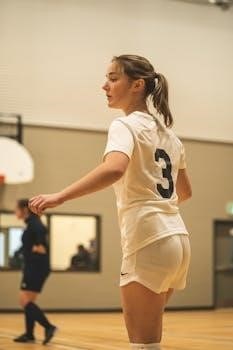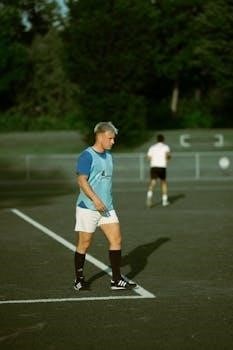A structured soccer training session plan is crucial for effective coaching. These plans help organize drills, ensuring players develop skills progressively. They also help coaches track progress, and provide a roadmap for each session. A good plan maximizes training time.
Importance of Structured Training
Structured training is vital in soccer, providing a clear path for player development. Without a plan, sessions can lack focus, hindering improvement. A well-structured plan ensures that each practice session has a specific purpose, whether it’s skill development, tactical understanding, or physical conditioning. It allows coaches to systematically introduce concepts, gradually increasing complexity. This approach is more effective than random drills, maximizing player progress. Furthermore, structured training helps coaches track each players development. It also allows for a better use of time, and optimizes the learning environment. This approach promotes team cohesion, and enhances player engagement.
Key Components of a Soccer Training Session Plan
Effective soccer training plans include warm-up activities, technical skill drills, and small-sided games. These components ensure a well-rounded session, targeting various aspects of player development.
Warm-up Activities
A proper warm-up is essential, activating both the body and the brain for the session ahead. It prepares players physically and mentally, allowing for harder, more intense training. Dynamic stretching should be incorporated, increasing blood flow and flexibility. Warm-ups also help prevent injuries by preparing muscles for the demands of soccer. Activities like light jogging, skipping, and leg swings are ideal. The goal is to elevate heart rate and improve joint mobility, ensuring players are ready for the technical and tactical drills to follow. Focus on movements that mimic soccer actions, which further enhances the warm-up’s effectiveness.
Technical Skill Drills
Technical skill drills are fundamental for developing individual player abilities. These drills should focus on core soccer skills like passing, dribbling, and ball control. A good session will incorporate various drills to address different skills, and ensure comprehensive development. Coaches should provide clear instructions and coaching points. Drills should be progressive, starting with basic movements and gradually increasing in complexity. Repetition is key to mastering these skills. Consider adding challenges to make the drills more engaging and effective. It’s important to tailor these drills to the players’ age and skill level. Remember to include both individual and paired drills.
Small-Sided Games
Small-sided games are essential for developing game awareness and decision-making skills in a soccer training plan. These games provide a fun and competitive environment. They involve fewer players and smaller fields, which allows for more touches on the ball. This will improve players’ technical skills and tactical understanding. Focus on creating situations that replicate match scenarios. This will help players apply their skills in game-like conditions. These games also encourage teamwork and communication. Coaches should vary the size and rules of the games to challenge the players. Remember to keep the games engaging and fun.

Planning Considerations
When creating soccer training plans, consider age-specific needs. Also, factor in space and resources available. Tailor drills to the players’ abilities. Adapt plans to ensure effective learning.
Age-Specific Training
Age-specific training is paramount in soccer development. Younger players, such as U6 to U10, benefit from basic skill drills, focusing on ball control and movement. As players progress to U12 and U14, training should introduce more complex tactics and team play. For U16 and older, sessions should emphasize advanced techniques, strategic positioning, and physical conditioning. Tailoring training to each age group ensures that players are challenged appropriately, fostering growth without overwhelming them. This approach allows for progressive development, matching the players’ physical and cognitive capabilities at each stage.
Space and Resource Availability
When planning a soccer training session, the available space and resources are critical considerations. If you have access to a full field, you can implement larger drills and practices with 11-a-side activities. Limited space, such as half a field or a smaller area, calls for adjustments like small-sided games or drills that can be performed in a compact space. Coaches should also consider the availability of equipment, like cones, balls, and goals, to tailor their sessions. Adjustments to training plans due to space and equipment constraints are necessary to ensure the effectiveness of every training session.
Resources for Session Plans
Many resources offer soccer session plans, including online platforms and databases. Coaches can also find free downloadable plans. These resources provide structured and age-appropriate activities.
Online Databases and Platforms
Numerous online databases and platforms offer extensive collections of soccer training session plans. These platforms often categorize plans by age group, skill level, and training focus, making it easier for coaches to find relevant content. Many provide detailed diagrams and instructions for each drill, enhancing understanding and implementation. Some platforms offer additional resources such as videos demonstrating the drills, coaching tips, and even tools to create customized plans. These digital resources are constantly updated, ensuring coaches have access to the most current and effective training methods. Subscriptions or free trials are common, allowing coaches to explore the offerings before committing.
Free Downloadable Plans
Many organizations and soccer websites provide free downloadable soccer training session plans. These resources often come in PDF format, allowing for easy access and printing. These plans frequently cover a range of ages and skill levels, and may include specific training themes. They are a great starting point for coaches seeking structured session ideas without cost. These free resources can be particularly useful for grassroots coaches and parent volunteers, providing essential guidance. However, coaches should remember to evaluate these plans and adapt them to fit the unique needs of their team, and the available resources.

Structuring a Weekly Training Schedule
A well-structured weekly training schedule balances various training types. This may include technical work, tactical sessions, and physical conditioning. It ensures players develop holistically and prevents overtraining. Recovery days are also essential.
Integrating Different Training Types
Integrating different training types is vital for comprehensive player development. A balanced approach ensures that players improve across all facets of the game. For example, a weekly schedule should incorporate technical drills focusing on ball control, passing, and shooting. These should then be followed with tactical sessions that emphasize game understanding, positioning, and decision making. Additionally, physical conditioning, such as speed, agility, and endurance training, must be included. It is essential to allocate adequate time for each training type, ensuring that players are not only skilled technically, but are also tactically aware and physically fit. This holistic method allows the team to perform at their peak potential.

Individual Player Development
Individual development is key; focus on strengths and weaknesses. Tailored training enhances specific skills. Coaches should provide personalized feedback. This approach helps players reach their full potential.
Focusing on Strengths and Weaknesses
Effective player development requires a dual approach, identifying both strengths and weaknesses. Players should refine their best skills, turning them into exceptional assets. Simultaneously, coaches must address areas needing improvement, ensuring well-rounded development. This involves creating specific drills and exercises. For example, if a player is excellent at passing but struggles with dribbling, practice sessions should include a balance of passing drills to reinforce their strength and dribbling exercises to address their weakness. Through consistent and targeted training, players can maximize their potential. This approach is vital for overall team success. It also builds confidence in each player.

Practical Tips for Effective Training
Effective training requires clear communication from coaches and fun activities. Maintaining player engagement is key, and focusing on key coaching points will enhance learning. This leads to positive development.
Coach’s Role and Key Coaching Points
The coach’s role is pivotal in a soccer training session, acting as a facilitator of learning and development. Coaches must clearly communicate the objectives of each drill, providing specific feedback to players. Key coaching points should focus on fundamental skills, such as ball control, passing accuracy, and tactical awareness. Coaches need to adjust training plans to meet player needs. Positive reinforcement is vital, along with constructive criticism. They must foster a supportive environment, promoting both individual and team growth. A coach must also be a good role model, demonstrating enthusiasm and dedication. Furthermore, they must plan and structure each session.
Maintaining Player Engagement and Fun
Keeping players engaged and ensuring training sessions are enjoyable is essential for long-term development and passion for soccer. Coaches should incorporate variety into drills and activities to prevent boredom. Small-sided games and challenges can make training more interactive and fun. It is important to create a positive and supportive atmosphere. Allowing players to have some input in the session can also increase engagement. Celebrate small successes, and focus on the effort and improvement. Using age-appropriate drills and games that are both challenging and achievable is crucial. The coach must also be enthusiastic and make the sessions exciting.
